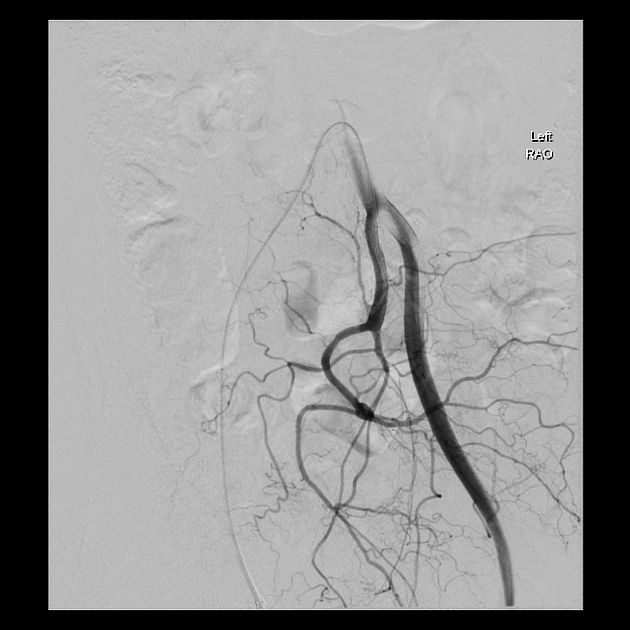Middle rectal artery
Citation, DOI, disclosures and article data
At the time the article was created Grace Florescu had no recorded disclosures.
View Grace Florescu's current disclosuresAt the time the article was last revised Harrison Slockee had no financial relationships to ineligible companies to disclose.
View Harrison Slockee's current disclosures- Middle haemorrhoidal artery
The middle rectal artery, also known as the middle hemorrhoidal artery, is a branch from the anterior division of the internal iliac artery supplying the rectum.
On this page:
Summary
origin: anterior division of the internal iliac artery
location: pelvis
supply: inferior rectum, seminal vesicles, prostate. In females, may be replaced by the uterine artery
branches: branches to rectum, seminal vesicle and prostate
Gross anatomy
Origin
The middle rectal artery originates from the anterior division of the internal iliac artery.
Course
It passes inferiorly towards the lower rectum, which it then supplies by splitting into several smaller branches prior to entering the rectum. It reaches the lower rectum laterally, along the lateral rectal ligament.
Branches
If a prostatic branch is present, it may also supply the seminal vesicle and prostate but more commonly, these branches arise from the inferior vesical artery.
Supply
The middle rectal artery supplies the inferior rectum, and anastomoses with the superior and inferior rectal arteries here.
Variant anatomy
The middle rectal artery may arise from a common origin with the inferior vesical artery. It may also arise from the internal pudendal artery, inferior gluteal artery or directly off the internal iliac artery. It may occasionally be absent in both sexes. It is more often absent in women than men. In some cases it may be replaced by an uterine artery. In males, the prostatic artery may arise from the middle rectal artery instead of from the inferior vesical artery.
Quiz questions
References
- 1. Last's anatomy, regional and applied. Churchill Livingstone. ISBN:044304662X. Read it at Google Books - Find it at Amazon
- 2. FAAA KLMMPFIACFRSM, Dalley AF, Agur AM. Clinically Oriented Anatomy, Sixth Edition. Lippincott Williams & Wilkins. ISBN:1605476528. Read it at Google Books - Find it at Amazon
- 3. DSc SSP. Gray's Anatomy. Churchill Livingstone. (2011) ISBN:0443066841. Read it at Google Books - Find it at Amazon
- 4. DiDio LJ, Diaz-Franco C, Schemainda R et-al. Morphology of the middle rectal arteries. A study of 30 cadaveric dissections. Surg Radiol Anat. 1987;8 (4): 229-36. Pubmed citation
Incoming Links
- Branches of anterior and posterior divisions of the internal iliac artery (mnemonic)
- Branches of internal iliac artery (mnemonic)
- Internal pudendal artery
- Internal iliac artery
- Aortoiliac occlusive disease
- Branches of the anterior division of the internal iliac artery (mnemonic)
- Anal canal
- Vagina
- Inferior vesical artery
- Superior rectal artery
- Ureter
- Prostate
- Rectum
Related articles: Anatomy: Abdominopelvic
- skeleton of the abdomen and pelvis
- muscles of the abdomen and pelvis
- spaces of the abdomen and pelvis
- anterior abdominal wall
- posterior abdominal wall
- abdominal cavity
- pelvic cavity
- perineum
- abdominal and pelvic viscera
- gastrointestinal tract
- spleen
- hepatobiliary system
-
endocrine system
-
adrenal gland
- adrenal vessels
- chromaffin cells
- variants
- pancreas
- organs of Zuckerkandl
-
adrenal gland
-
urinary system
-
kidney
- renal pelvis
- renal sinus
- avascular plane of Brodel
-
variants
- number
- fusion
- location
- shape
- ureter
- urinary bladder
- urethra
- embryology
-
kidney
- male reproductive system
-
female reproductive system
- vulva
- vagina
- uterus
- adnexa
- Fallopian tubes
- ovaries
- broad ligament (mnemonic)
- variant anatomy
- embryology
- blood supply of the abdomen and pelvis
- arteries
-
abdominal aorta
- inferior phrenic artery
- celiac artery
- superior mesenteric artery
- middle suprarenal artery
- renal artery (variant anatomy)
- gonadal artery (ovarian artery | testicular artery)
- inferior mesenteric artery
- lumbar arteries
- median sacral artery
-
common iliac artery
- external iliac artery
-
internal iliac artery (mnemonic)
- anterior division
- umbilical artery
- superior vesical artery
- obturator artery
- vaginal artery
- inferior vesical artery
- uterine artery
- middle rectal artery
-
internal pudendal artery
- inferior rectal artery
-
perineal artery
- posterior scrotal artery
- transverse perineal artery
- artery to the bulb
- deep artery of the penis/clitoris
- dorsal artery of the penis/clitoris
- inferior gluteal artery
- posterior division (mnemonic)
- variant anatomy
- anterior division
-
abdominal aorta
- portal venous system
- veins
- anastomoses
- arterioarterial anastomoses
- portal-systemic venous collateral pathways
- watershed areas
- arteries
- lymphatics
- innervation of the abdomen and pelvis
- thoracic splanchnic nerves
- lumbar plexus
-
sacral plexus
- lumbosacral trunk
- sciatic nerve
- superior gluteal nerve
- inferior gluteal nerve
- nerve to piriformis
- perforating cutaneous nerve
- posterior femoral cutaneous nerve
- parasympathetic pelvic splanchnic nerves
- pudendal nerve
- nerve to quadratus femoris and inferior gemellus muscles
- nerve to internal obturator and superior gemellus muscles
- autonomic ganglia and plexuses





 Unable to process the form. Check for errors and try again.
Unable to process the form. Check for errors and try again.